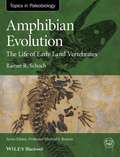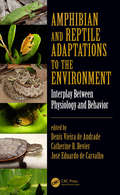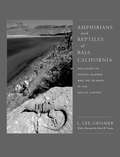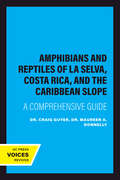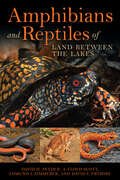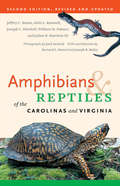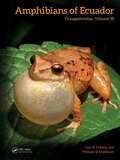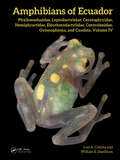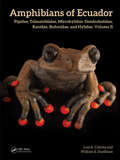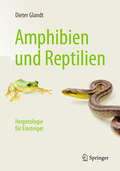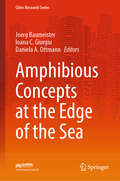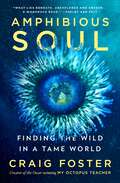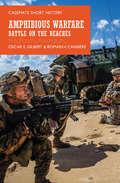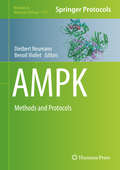- Table View
- List View
Amphibian Evolution
by Rainer R. SchochThis book focuses on the first vertebrates to conquer land and their long journey to become fully independent from the water. It traces the origin of tetrapod features and tries to explain how and why they transformed into organs that permit life on land. Although the major frame of the topic lies in the past 370 million years and necessarily deals with many fossils, it is far from restricted to paleontology. The aim is to achieve a comprehensive picture of amphibian evolution. It focuses on major questions in current paleobiology: how diverse were the early tetrapods? In which environments did they live, and how did they come to be preserved? What do we know about the soft body of extinct amphibians, and what does that tell us about the evolution of crucial organs during the transition to land? How did early amphibians develop and grow, and which were the major factors of their evolution?The Topics in Paleobiology Series is published in collaboration with the Palaeontological Association, and is edited by Professor Mike Benton, University of Bristol.Books in the series provide a summary of the current state of knowledge, a trusted route into the primary literature, and will act as pointers for future directions for research. As well as volumes on individual groups, the series will also deal with topics that have a cross-cutting relevance, such as the evolution of significant ecosystems, particular key times and events in the history of life, climate change, and the application of a new techniques such as molecular palaeontology.The books are written by leading international experts and will be pitched at a level suitable for advanced undergraduates, postgraduates, and researchers in both the paleontological and biological sciences.
Amphibian and Reptile Adaptations to the Environment: Interplay Between Physiology and Behavior
by Denis Vieira de Andrade Catherine R. Bevier José Eduardo de CarvalhoDespite their diversity, amphibians and reptiles share many physiological traits, such as their dependence on external heat sources for body temperature regulation, that are of pivotal importance to their ability to cope with the environment. Considerable variation in physiological capabilities exists in these groups and often can be related to seasonal and geographic differences in environmental parameters. This book provides a comprehensive and integrative view of the interplay between physiology and behavior in amphibians and reptiles, leading to a better understanding of the subject. The book covers topics that have recently been in the spotlight for scientific research on the physiology, behavior, and conservation of amphibians and reptiles. It brings together recent information from a range of disciplines that address critical topics for understanding their biology. As these studies are scattered across articles in specialized journals, this book provides a single and expanded source summarizing such advancements. Amphibian and Reptile Adaptations to the Environment: Interplay Between Physiology and Behavior maintains a solid scientific basis for the biological topics covered. However, it presents the material in a clear and direct manner so that it is accessible even to non-biologists interested in the basic biology, behavior, and ecology of these animals as well as how these elements are connected to their conservation.
Amphibians and Reptiles of Baja California, Including Its Pacific Islands and the Islands in the Sea of Cortés
by L. Lee GrismerThis is a comprehensive review of what is known about all of the species of amphibians and reptiles in Baja California.
Amphibians and Reptiles of La Selva, Costa Rica, and the Caribbean Slope: A Comprehensive Guide
by Dr. Craig Guyer Dr. Maureen A. DonnellyThis field guide at last provides an authoritative and handy source for identifying amphibians and reptiles of Costa Rica's renowned Atlantic lowland tropical forests. Colorful frogs, lizards that can run across water, snapping turtles, spotted geckos, boa constrictors, crocodiles, and many other fascinating yet secretive species of amphibians and reptiles flourish in the region's myriad microhabitats. The La Selva Biological Station, a protected reserve, boasts a rich biota, making it and the surrounding area one of the most visited tropical forest sites in the world. For travelers, ecotourists, and biologists, this comprehensive guide, written by two distinguished experts on the area's amphibians and reptiles, will be an essential resource while visiting La Selva and the surrounding tropical forests of Costa Rica. In addition to providing reliable field identification, it will help visitors to this area better understand the overall role of Central American amphibians and reptiles in the natural world as well as conservation efforts now being undertaken to ensure the survival of these intriguing creatures.* 138 frogs, lizards, snakes, and crocodiles are included in keys based primarily on color patterns for easy identification * Each species is illustrated with a color photograph; the guide also features range maps and black-and-white drawings * Includes an overview of the natural history of each amphibian and reptile and gives helpful tips on where to observe them
Amphibians and Reptiles of Land Between the Lakes
by David H. Snyder A. Floyd Scott Edmund J. Zimmerer David F. FrymireKnown for its natural beauty, Land Between the Lakes National Recreation Area is the largest inland peninsula in the United States. Consisting of 170,000 acres of forested and protected public land between Kentucky Lake (Tennessee River) and Lake Barkley
Amphibians and Reptiles of the Carolinas and Virginia
by William M. Palmer Jack Dermid Julian R. Harrison Alvin L. Braswell Jeffrey C. BeaneRevised and updated to reflect the most current science, and including 30 new species, this authoritative and comprehensive volume is the definitive guide to the amphibians and reptiles of the Carolinas and Virginia. The new edition features 189 species of salamanders, frogs, crocodilians, turtles, lizards, and snakes, with updated color photographs, descriptions, and distribution maps for each species. It is an indispensable guide for zoologists, amateur naturalists, environmentalists, backpackers, campers, hikers, and everyone interested in the outdoors.
Amphibians of Ecuador: Craugastoridae
by William E. Duellman Luis A. ColomaAmphibians of Ecuador: Craugastoridae. Volume III is the third in a four-volume series that provides comprehensive, well-illustrated, and authoritative insights, making it an invaluable resource for biologists, conservationists, and others. The series explores, in comprehensive detail, the cultural history and the rich amphibian diversity of Ecuador, providing a thorough review of biogeography, amphibian declines, and conservation.Volume III specifically focuses on Craugastoridae. Characteristics of each species are listed, defined, and compared to other similar species. Reproductive behavior, where known, is described, as are data on vocalizations. Amphibian distributions are detailed and illustrated with physiographic maps with dots. The volume also addresses the declines, extinctions, and conservation status of each species, noting their occurrence in reserves.KEY FEATURES: Provides detailed and comprehensive accounts for all Craugastoridae species from Ecuador New data are incorporated for many species Describes with full color maps the distribution of all known taxa Includes information on the ecology, reproduction, and behavior of all taxa
Amphibians of Ecuador: Phyllomedusidae, Leptodactylidae, Ceratophryidae, Hemiphractidae, Eleutherodactylidae, Centrolenidae, Gymnophiona and Caudata, Volume IV
by William E. Duellman Luis A. ColomaAmphibians of Ecuador, Volume IV is the final installment in a four-volume series that provides comprehensive, well-illustrated, and authoritative insights into the amphibian species of Ecuador, making it an invaluable resource for biologists, conservationists, and others. The series explores, in comprehensive detail, the cultural history and the rich amphibian diversity of Ecuador, providing a thorough review of biogeography, amphibian declines, and conservation.Volume IV specifically focuses in Phyllomedusidae, Leptodactylidae, Ceratophryidae, Hemiphractidae, Eleutherodactylidae, Centrolenidae, Gymnophiona, and Caudata. Characteristics of each species are listed, defined, and compared to similar other species. Reproductive behavior, where known, is described as are data on vocalizations, larvae and ontogenetic changes. Amphibian distributions are detailed and illustrated with physiographic maps with dots. The volume also addresses the declines, extinctions, and conservation status of each species, highlighting their occurrence in protected areas.Key Features: Provides detailed and comprehensive accounts for all species from Ecuador of Phyllomedusidae, Leptodactylidae, Ceratophryidae, Hemiphractidae, Eleutherodactylidae, Centrolenidae, Gymnophiona, and Caudata. An Addendum includes accounts of species described from 2023 to 2024. New data are incorporated for many species. Describes with full color maps the distribution of all known taxa. Includes information on the ecology, reproduction, and behavior of all taxa.
Amphibians of Ecuador: Pipidae, Telmatobiidae, Microhylidae, Dendrobatidae, Ranidae, Bufonidae, and Hylidae, Volume II
by Luis A. Coloma William E. DuellmanThis book is the second of four volumes, which are comprehensive, well-illustrated, and authoritative works invaluable to biologists, conservationists, and others. It explores, in comprehensive detail, the rich amphibian diversity of Ecuador, providing a thorough review of biogeography, amphibian declines, and conservation. This volume covers Pipidae, Telmatobiidae, Microhylidae, Dendrobatidae, Ranidae, Bufonidae, and Hylidae. Characteristics of each species are listed, defined, and compared to similar other species. Reproductive behavior, where known, is described, as are data on vocalizations, larvae, and ontogenetic changes. Amphibian distributions are illustrated with physiographic maps with dots. Each volume addresses the declines, extinctions, and conservation status of each species and provides notations of their occurrence in reserves.KEY FEATURES Provides detailed and authoritative accounts for each species in seven families: Pipidae, Telmatobiidae, Microhylidae, Dendrobatidae, Ranidae, Bufonidae, and Hylidae New data are incorporated for many species Describes with full-color maps the distribution of all known taxa Includes information on the ecology, reproduction, and behavior of all taxa
Amphibien und Reptilien: Herpetologie für Einsteiger
by Dieter GlandtAls #65533;beraus erfahrener Herpetologe, dessen Wissen und Erfahrung in zahlreiche Fachb#65533;cher Eingang gefunden hat, ist Dieter Glandt pr#65533;destiniert, dieses fachlich fundierte und gleichzeitig gut verst#65533;ndliche Buch zu den Lurchen und Kriechtieren zu verfassen. Brillante Fotos renommierter Fotografen sowie didaktisch ansprechende Grafiken runden das Buch ab und erlauben ein Schm#65533;kern in diesem f#65533;r den Wissenschaftler anregenden wie auch Laien verst#65533;ndlichen Werk. Wie lassen sich die Tiere am besten beobachten und bestimmen? Der Autor erl#65533;utert einige wichtige Methoden, etwa die immer h#65533;ufiger genutzten Wasserfallen. Wenn Sie wissen wollen, f#65533;r welchen Zweck sich welche Methode am besten eignet, dann finden Sie hier wertvolle Entscheidungshilfen. Viele Lurche und Kriechtiere sind stark gef#65533;hrdet oder vom Aussterben bedroht. Warum dies so ist und was sich dagegen tun l#65533;sst, ist ein Schwerpunkt dieses Buches. Auch auf der Suche nach Tipps f#65533;r die Neuanlage von Kleingew#65533;ssern und die Pflege #65533;lterer Lebensr#65533;ume sowie Hinweise f#65533;r den Schutz der hochgradig bedrohten Meeresschildkr#65533;ten finden sich in dieser Einf#65533;hrung.
Amphibious Concepts at the Edge of the Sea (Cities Research Series)
by Joerg Baumeister Daniela A. Ottmann Ioana C. GiurgiuThis book explores interfaces between land and sea and their geostrategic, ecological, urban, productive, indigenous, legal, historical, and artistic dimensions. The oceans, comprising two-thirds of the earth's surface, were initially utilised mainly for transportation and fishing. Today they serve diverse purposes such as supplying energy, freshwater, mineral resources, supporting leisure activities, and providing habitat. Additionally, the UN set up the first international agreement establishing Marine Protection Areas for a third of the sea to mitigate the growing use and exploitation. The more interest in oceans' territories increases, the more the question arises about the beneficial evolution of their physical and legal boundaries. What innovative amphibious concepts can be developed for the edge of the sea? The book pushes the boundaries of current knowledge to provide a deeper insight into the upcoming challenges and opportunities, makingit easier to apply the best strategies for a healthy future for both the ocean and humanity.
Amphibious Soul: Finding the Wild in a Tame World
by Craig Foster“An important book that will transform how we think about being human. … that will inspire hope.”—Jane GoodallHow can we reclaim the soul-deepening wildness that grounds us and energizes us when so much of the modern world seems designed to tame us?In this thrilling memoir of a life spent exploring the most incredible places on Earth—from the Great African Seaforest to the crocodile lairs of the Okavango Delta—Craig Foster reveals how we can attend to the earthly beauty around us and deepen our love for all living things, whether we make our homes in the country, the city, or anywhere in between.Foster explores his struggles to remain present to life when a disconnection from nature and the demands of his professional life begin to deaden his senses. And his own reliance on nature’s rejuvenating spiritual power is put to the test when catastrophe strikes close to home.Foster’s lyrical, riveting Amphibious Soul draws on his decades of daily ocean dives, wisdom from Indigenous teachers, and leading-edge science.
Amphibious Warfare: Battle on the Beaches (Casemate Short History)
by Oscar E. Gilbert Romain Cansiere&“An easily accessible short history&” of offensive military operations on hostile shores from the authors of First to Fight: The U.S. Marines in World War I (Midwest Book Review). One of the most difficult types of warfare to master, landing on a hostile beach requires scrupulous planning and intense coordination between the air, sea, and land forces. With a history reaching back to the Persians landing on the Greek shores at the Battle of Marathon in 490 BC, it was the First World War that marked the beginning of modern amphibious warfare, with the Royal Marines combining their efforts with the Royal Navy. Despite the disastrous Gallipoli amphibious operation to seize the Dardanelles Straits in 1915, the Royal Navy and US Marine Corps continued to develop new landing crafts through the interwar years. The Second World War proved more successful for amphibious warfare, with the Japanese invasion of the Philippines in 1941 crushing the American forces defending the Pacific islands and the D-Day landings by the Allied troops in 1944 initiating the beginning of the end of the war in Europe. This accessible short history looks at the historical development of amphibious warfare, telling the stories of particular landings and the units that have taken part in this unique type of warfare. The Royal Marines and US Marine Corps continue to evolve and play a crucial role in defense today, with specialized amphibious warfare ships being deployed to enable elite forces to respond promptly to threats across the globe. &“A brief but very useful overview of an important aspect of modern warfare.&” —Baird Maritime
Ampk: Methods And Protocols (Methods In Molecular Biology #1732)
by Benoit Viollet Dietbert NeumannThis volume explores the latest methods used to study AMPK by computational, biochemical, biophysical, cellular, and ex vivo and in vivo approaches. The chapters in this book cover specific topics, such as methods to measure change in cellular energy metabolism and analyze metabolic pathways regulated by AMPK; bioinformatics tools to identify AMPK targets; knockdown of AMPK by CRISPR-Cas9; production and crystallization of full-length human AMP-activated protein kinase; cell-free assays to measure the effects of regulatory ligands on AMPK; use of sensors of AMPK activity; AMPK protein interaction by yeast two-hybrid; the role of AMPK in inflammation and autophagy; analyzing the AMPK function in C. elegans and mammals (with special focus on skeletal muscle, blood vessels, kidneys, pancreatic islets and hypothalamus); and human γ2 AMPK mutations. Written in the highly successful Methods in Molecular Biology series format, chapters include introductions to their respective topics, lists of the necessary materials and reagents, step-by-step, readily reproducible laboratory protocols, and tips on troubleshooting and avoiding known pitfalls.
Amplifying Informal Science Learning: Rethinking Research, Design, and Engagement
by Judy Diamond Sherman RosenfeldThis collection explores the broad landscape of current and future out-of-school science learning environments. Written by leading experts and innovators in informal science learning, these thoughtful and critical essays examine the changing nature of informal institutions such as science museums, zoos, nature centers, planetariums, aquaria, and botanical gardens and their impact on science education. The book examines the learning opportunities and challenges created by community-based experiences including citizen science, makerspaces, science media, escape rooms, hobby groups, and gaming. Based on current practices, case studies, and research, the book focuses on four cross-cutting themes – inclusivity, digital engagement, community partnerships, and bridging formal and informal learning – to examine how people learn science informally. The book will be of interest to STEM (science, technology, engineering and math) educators – both in and out of school – designers of science and experiential education programs, and those interested in building STEM learning ecosystems in their communities.
Amplitude Modulation of Pulsation Modes in Delta Scuti Stars (Springer Theses)
by Dominic M. BowmanThis outstanding thesis by Dominic Bowman provides a thorough investigation of long-standing questions as to whether amplitude modulation is astrophysical, whether it offers insights into pulsating stars, and whether simple beating of modes with stable amplitudes is unrecognised because of a lack of frequency resolution. In this thesis, the author studied a uniform sample of 983 delta Scuti stars—the most common type of main-sequence heat engine pulsator—that were observed nearly continuously for 4 years at stunning photometric precision of only a few parts per million by the Kepler space mission. With no mission planned to supersede the Kepler 4-year data set, this thesis will stand as the definitive study of these questions for many years. With revolutionary photometric data from the planet-hunting Kepler space mission, asteroseismic studies have been carried out on many hundreds of main-sequence solar-type stars and about 10,000 red giants. It is easy to understand why those stochastically driven stars have highly variable amplitudes. Over much of the rest of the Hertzsprung–Russell (HR) diagram, stellar pulsations are driven by heat mechanisms, which are much more regular than the stochastic driving in solar-like pulsators. Yet for decades, amplitude and frequency modulation of pulsation modes have been observed in almost all types of heat-driven pulsating stars. The author shows that the amplitude and frequency modulation are astrophysical, and he has investigated their implications and prospects to provide new insights into the delta Scuti stars and the many other types of heat-engine pulsators across the HR diagram.
Amsco's Science Grade 8
by Paul S. Cohen Anthony V. SorrentinoProvides a clear and concise presentation of middle school science concepts. This book discusses current ideas in science taken straight from the headlines.
Amsco's Science, Grade 7
by Paul S. Cohen Anthony V. SorrentinoProvides a clear and concise presentation of middle school science concepts.
Amyloid Fibrils and Prefibrillar Aggregates
by Daniel Erik OtzenSumming up almost a decade of biomedical research, this topical and eagerly awaited handbook is the first reference on the topic to incorporate recent breakthroughs in amyloid research.The first part covers the structural biology of amyloid fibrils and pre-fibrillar assemblies, including a description of current models for amyloid formation. The second part looks at the diagnosis and biomedical study of amyloid in humans and in animal models, while the final section discusses pharmacological approaches to manipulating amyloid and also looks at its physiological roles in lower and higher organisms. For Biochemists, Molecular Biologists, Neurobiologists, Neurophysiologists and those working in the Pharmaceutical Industry.
Amyloid Precursor Protein: A Practical Approach
by Weiming Xia Huaxi XuIn the search for an effective treatment for Alzheimer's disease, APP is a unique model protein that illustrates the wide array of basic and sophisticated characterization techniques available. Exploring a variety of biological techniques to clarify the structure and function of this transmembrane protein, this text presents each method with detail
Amyloid Proteins: Methods And Protocols (Methods in Molecular Biology #299)
by Einar M. SigurdssonA proven collection of readily reproducible techniques for studying amyloid proteins and their involvement in the etiology, pathogenesis, diagnosis, and therapy of amyloid diseases. The contributors provide methods for the preparation of amyloid and its precursors (oligomers and protofibrils), in vitro assays and analytical techniques for their study, and cell culture models and assays for the production of amyloid proteins. Additional chapters present readily reproducible techniques for amyloid extraction from tissue, its detection in vitro and in vivo, as well as nontransgenic methods for developing amyloid mouse models. The protocols follow the successful Methods in Molecular BiologyTM series format, each offering step-by-step laboratory instructions, an introduction outlining the principle behind the technique, lists of the necessary equipment and reagents, and tips on troubleshooting and avoiding known pitfalls.
Amyloid Proteins: Methods and Protocols (Methods in Molecular Biology #1779)
by Einar M. Sigurdsson María Gasset Miguel CaleroThis third edition volume expands on the previous editions with many new chapters that cover the latest techniques and topics that were not addressed in the previous volumes. The chapters in this book are divided into three parts: Part One covers in vitro assays that focus on a variety of amyloids and how to study these peptides and proteins. Part Two describes cell culture models and assays, and Part Three explores methods on how to extract amyloid from tissue, its detection, and its characterization in vitro or in vivo. Written in the highly successful Methods in Molecular Biology series format, chapters include introductions to their respective topics, lists of the necessary materials and reagents, step-by-step, readily reproducible laboratory protocols, and tips on troubleshooting and avoiding known pitfalls.Cutting-edge and authoritative, Amyloid Proteins: Methods and Protocols, Third Edition is a valuable resource for both students and scientists who are new to the field, as well as experienced researchers who would like to progress their research with the latest available techniques.
Amyloid Proteins: Methods and Protocols (Methods in Molecular Biology #849)
by Einar M. Sigurdsson María Gasset Miguel CaleroAmyloid diseases are characterized by the deposition of insoluble fibrous amyloid proteins. The word "amyloid" indicates a starch-like compound, and though a misnomer, continues to be the accepted term for this group of protein conformational disorders. The second edition of Amyloid Proteins expands upon the previous edition with current, detailed protocols for the preparation of amyloid and its precursors, specific analytical methods for studying these proteins, cell culture models and assays for production of amyloid proteins, and protocols for amyloid extraction from tissue, its detection in vitro and in vivo, as well as nontransgenic methods for developing amyloid mouse models. Written in the highly successful Methods in Molecular BiologyTM series format, chapters include introductions to their respective topics, lists of the necessary materials and reagents, step-by-step, readily reproducible laboratory protocols, and key tips on troubleshooting and avoiding known pitfalls.Authoritative and practical, Amyloid Proteins, Second Edition seeks to aid scientists in the amyloid field to establish new techniques in their laboratories. Authoritative and practical, Amyloid Proteins, Second Edition seeks to aid scientists in the amyloid field to establish new techniques in their laboratories.
Amyloid and Amyloidosis
by Robert A. Kyle Gilles Grateau Martha SkinnerThis authoritative volume contains 179 chapters by international experts on recent developments in our understanding of amyloid proteins, protein folding disorders, and new and proposed clinical trials in amyloidosis. Topics include detection and characterization techniques; biological functions; genetics; disorders, diagnosis, and treatments, incl
An Advanced Course in Computational Nuclear Physics: Bridging the Scales from Quarks to Neutron Stars (Lecture Notes in Physics #936)
by Morten Hjorth-Jensen Maria Paola Lombardo Ubirajara Van KolckThis graduate-level text collects and synthesizes a series of ten lectures on the nuclear quantum many-body problem. Starting from our current understanding of the underlying forces, it presents recent advances within the field of lattice quantum chromodynamics before going on to discuss effective field theories, central many-body methods like Monte Carlo methods, coupled cluster theories, the similarity renormalization group approach, Green's function methods and large-scale diagonalization approaches. Algorithmic and computational advances show particular promise for breakthroughs in predictive power, including proper error estimates, a better understanding of the underlying effective degrees of freedom and of the respective forces at play. Enabled by recent improvements in theoretical, experimental and numerical techniques, the state-of-the art applications considered in this volume span the entire range, from our smallest components - quarks and gluons as the mediators of the strong force - to the computation of the equation of state for neutron star matter. The lectures presented provide an in-depth exposition of the underlying theoretical and algorithmic approaches as well details of the numerical implementation of the methods discussed. Several also include links to numerical software and benchmark calculations, which readers can use to develop their own programs for tackling challenging nuclear many-body problems.
